Section 1.1 Section 1.2 Section 1.3 - The Student Room
Section 1.1 Section 1.2 Section 1.3 - The Student Room
Section 1.1 Section 1.2 Section 1.3 - The Student Room
You also want an ePaper? Increase the reach of your titles
YUMPU automatically turns print PDFs into web optimized ePapers that Google loves.
SECTION 4<br />
6 a<br />
H<br />
H<br />
H<br />
H<br />
b<br />
H 3 C<br />
H 3 C<br />
C<br />
C C<br />
* H C C<br />
H H<br />
CH 3<br />
H 3 C<br />
C<br />
C C<br />
* H C C<br />
H<br />
CH 3<br />
H 3 C<br />
CH<br />
CH 3<br />
H<br />
C<br />
H<br />
C<br />
C<br />
H<br />
C<br />
H<br />
C<br />
C<br />
H<br />
H<br />
H<br />
H<br />
H<br />
O<br />
limonene<br />
carvone<br />
c<br />
No: the carbon which was chiral is<br />
now bonded in the same way in both<br />
directions around the ring.<br />
<strong>Section</strong> 4.1<br />
1 a Standard enthalpy change of combustion is the<br />
enthalpy change when 1 mole of the compound is<br />
burnt completely in oxygen, under standard<br />
conditions (ie the compound and the products in their<br />
most stable states at 1 atmosphere pressure and at a<br />
stated temperature, often 298 K).<br />
b Standard enthalpy change of formation is the<br />
enthalpy change when 1 mole of a compound is<br />
formed from its elements, with both the compound<br />
and its elements being in their standard states (ie their<br />
most stable state at 1 atmosphere pressure and at a<br />
stated temperature, often 298 K).<br />
2 <strong>The</strong> formation of a compound from its elements may be<br />
an exothermic reaction (DH f<br />
negative) or an<br />
endothermic reaction (DH f<br />
positive). However, energy is<br />
liberated whenever a substance burns, so combustion<br />
reactions are always exothermic (DH c<br />
negative).<br />
3<br />
Enthalpy<br />
1<br />
1<br />
2 H 2 (g) + 2 Cl 2 (g)<br />
DH = –92.3 kJ mol –1<br />
HCl(g)<br />
Progress of reaction<br />
e 6C(s) + 6H 2<br />
(g) + 3O 2<br />
(g) Æ C 6<br />
H 12<br />
O 6<br />
(s)<br />
f C 6<br />
H 12<br />
O 6<br />
(s) + 6O 2<br />
(g) Æ 6CO 2<br />
(g) + 6H 2<br />
O(l)<br />
5 DH c<br />
!(C) is enthalpy change when 1 mole of carbon<br />
burned completely under standard conditions, ie<br />
C(s) + O 2<br />
(g) Æ CO 2<br />
(g)<br />
DH f<br />
!(CO 2<br />
) is enthalpy change when 1 mole of carbon<br />
dioxide is formed from its elements with both the carbon<br />
dioxide and its constituent elements in their standard<br />
states, ie<br />
C(s) + O 2<br />
(g) Æ CO 2<br />
(g)<br />
6 a <strong>The</strong>rmometer, measuring cylinder, gas meter.<br />
b Volume of water used, temperature rise of water,<br />
volume of gas used.<br />
c Cooling losses, impurity of the gas, etc.<br />
7 a DH = –667 kJ mol –1<br />
b Much heat was lost to the surroundings in the<br />
experiment whereas the accurate DH value in the data<br />
book would have been determined using a calorimeter<br />
in which very little heat is lost.<br />
8 a M r<br />
(C 7<br />
H 16<br />
) = 100<br />
b i 481.7 kJ released ii 481 700 kJ released<br />
(Assumed combustion is complete and CO 2<br />
and H 2<br />
O<br />
are the only products. Also, that combustion is carried<br />
out under standard conditions.)<br />
c Density of heptane<br />
9 a H 2<br />
(g) + O 2<br />
(g) Æ H 2<br />
O(l)<br />
b DH f,<br />
! 298<br />
(H 2<br />
O) = –286 kJ mol –1<br />
c –143 kJ (assuming combustion takes place under<br />
standard conditions)<br />
d +286 kJ mol –1<br />
Enthalpy<br />
1<br />
1<br />
2<br />
2 H 2 (g) + I 2 (s)<br />
HI(g)<br />
DH = +26.5 kJ mol –1<br />
Progress of reaction<br />
10 a Enthalpy change of formation of propane.<br />
b Enthalpy change of combustion of 3 moles of carbon<br />
and 4 moles of hydrogen.<br />
c Enthalpy change of combustion of propane.<br />
d DH 1<br />
+ DH 3<br />
= DH 2<br />
e DH 1<br />
= DH 2<br />
– DH 3<br />
= 3(–393) kJ mol –1 + 4(–286) kJ mol –1<br />
– (–2220) kJ mol –1<br />
= –103 kJ mol –1<br />
11 a 4C(s) + 5H 2<br />
(g) Æ C 4<br />
H 10<br />
(g)<br />
b<br />
DH<br />
4C(s) + 5H 2<br />
(g)<br />
1<br />
C 4<br />
H 10<br />
(g)<br />
4 a 2C(s) + 3H 2<br />
(g) + O 2<br />
(g) Æ C 2<br />
H 5<br />
OH(l)<br />
b C 2<br />
H 5<br />
OH(l) + 3O 2<br />
(g) Æ 2CO 2<br />
(g) + 3H 2<br />
O(l)<br />
c 4C(s) + 5H 2<br />
(g) Æ C 4<br />
H 10<br />
(g)<br />
d C 4<br />
H 10<br />
(g) + 6 O 2<br />
(g) Æ 4CO 2<br />
(g) + 5H 2<br />
O(l)<br />
+ 6 O 2<br />
(g) DH 2<br />
DH 3<br />
+ 6 O 2<br />
(g)<br />
4CO 2<br />
(g) + 5H 2<br />
O(l)<br />
169


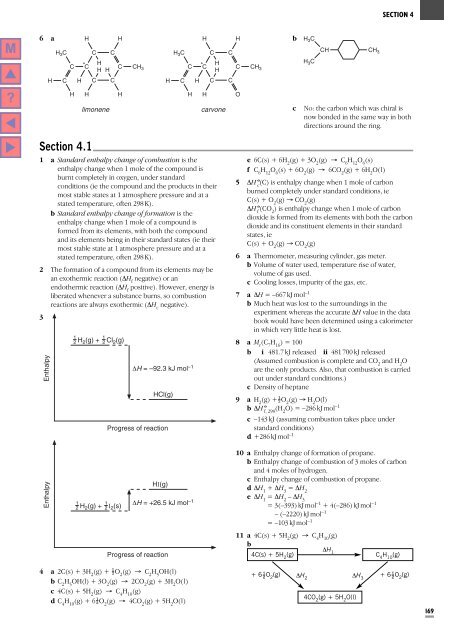
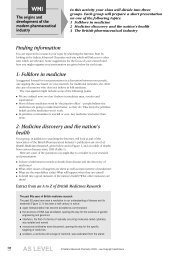
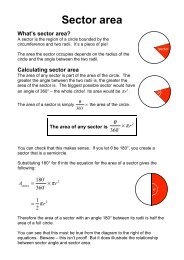
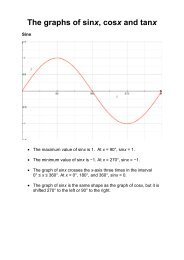
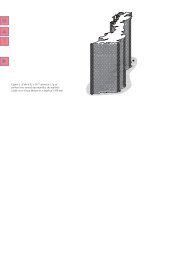

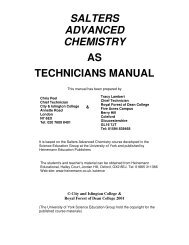


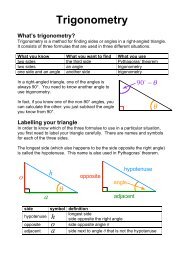
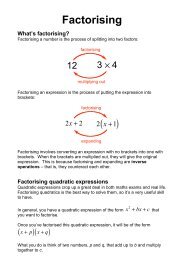
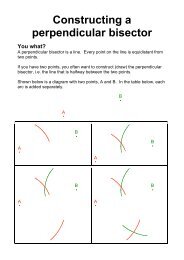

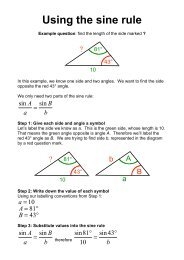
![ISI Web of Knowledge [v.4.10] - All Databases Results - Benjamin-Mills](https://img.yumpu.com/39253071/1/184x260/isi-web-of-knowledge-v410-all-databases-results-benjamin-mills.jpg?quality=85)